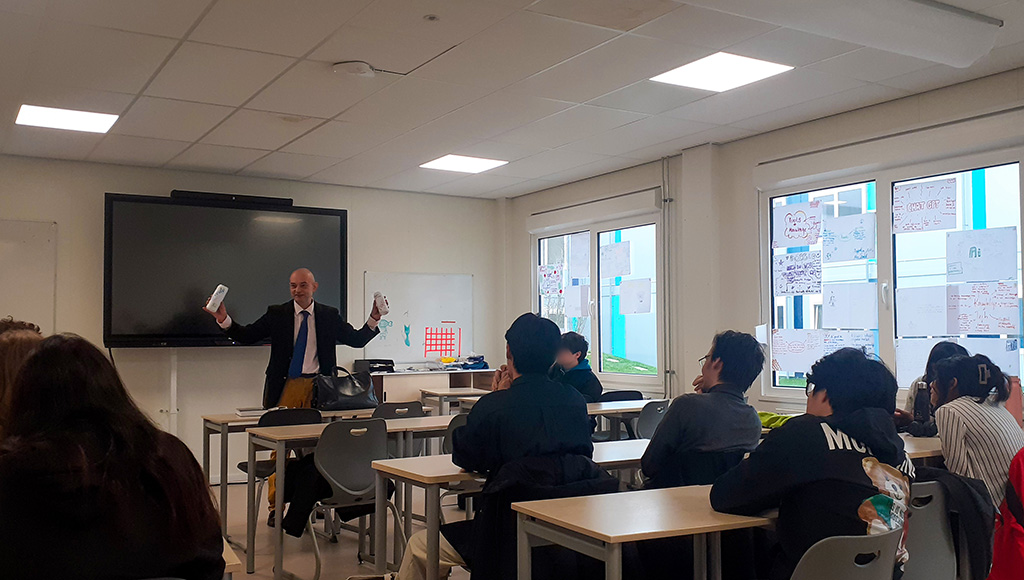In November the Bassetti Foundation renewed its collaboration with the International School Utrecht, as Jonathan Hankins delivered a series of lessons for the Diploma Program Theory of Knowledge course and within the school’s English language hub.
The lessons aimed to offer a different perspective on ethics. Rather than being thought of as an abstract idea, ethics is seen as an integral factor that is found within any design or development process, while the end result of the design process (a product) is seen as embodying the ethics of its design process.
With the participation of Angelo Hankins, Jonathan has been developing a form of Critical Future Design that can be used within a Performance Lecture to discuss how this treatment of ethics could be used within Responsible Innovation.
The Methodology
In Critical Future Design methodologies, fictional (but almost feasible) products are brought back from a future world to be used to address questions around decision-making within their design process. In their new methodological approach, Angelo and Jonathan combine this methodology with that of Performance Lecture, with the room usually used for lessons (lecture hall or classroom) turned into a performance space (in this case for a sales pitch). One characteristic of a performance lecture is that it deliberately leaves things unsaid so that they can be discussed. Through the theatrical presentation of a near future product, participants are drawn into a world that is not dissimilar to that of today, as the product explanation uses typical modern day structures, processes and actions. This gives participants the possibility of thinking about the introduction of a single product and its possible effects upon society within a context that is believable.
The Performance Lecture given at ISUtrecht builds upon a methodology that was primarily developed during the A Society for All Ages. Longevity-driven design Masters course at Milan Polytechnic (2022-23) and the Interaction Design and Service Design Masters courses at Milan Domus Academy (2023). The collaboration with the International School offered the chance to further develop the approach to include a broad set of (younger) students (those in the first year of the Diploma Program), as well as offering the experience of integrating the ethical debate into language lessons.
The Experience
The lessons began with a question and discussion of how we might define ethics. For the purposes of this approach, ethics was taken as a process of weighting values during a decision-making process. An example of ethics in practice was taken from a fictional development tract of a new mobile telephone: The designers want to design a repairable and updatable product with open access software, but they also want the phone to be affordable. The inclusion of a removeable battery might put production costs up however, leading to a balancing of competing values (sustainability versus affordability). This weighting or balancing of competing values is described by Responsible Innovation practitioner Jeroen Van den Hoven as the problem of moral overload.
From this perspective, a product embodies the ethics within its design process. To make this process more visible, a fictional product can be brought back from the near future very much as an archeologist might bring something back from the past, so its history of decision-making and value balancing can be discussed as it returns from the future to the present. The approach aims to place a product in a future context and work back through its design process to today, rather than addressing the ethical debate from the present using prediction, making the decision-making process easier to see and discuss.
The critical future design product used was a nanotechnology drink. It was presented in two versions: Longevity: Now Available in Cans! and Happiness: Now Available in Cans!
The students were presented with Longevity, a drink that allows them to live longer as the nanotechnology it contains can be used to control the body’s production of adrenaline. This allows sleep patterns to be made more regular, in effect making the body into a machine that can be regulated ‘in flow’. They were then presented with the Happiness version of the drink that uses the same technology to enable endorphin and dopamine production, allowing them not only a longer life but also guaranteed happiness at their fingertips.
The products were presented without introduction and in a very positive light as a new nanotechnology innovation. The drinks contain nanobots that once ingested, live in the drinker’s body. Through an app the nanobots can be used to make the body produce a variety of hormones and brain transmitters (adrenaline, dopamine and endorphins), enabling the body to be ‘fine tuned’.
After the presentation the students engaged in discussion about the presentation, what the implications for society might be for its marketing and mass use and ideas around techno-utopian future scenarios.
A timeline was then used to discuss different points in the design process, which led to discussions about truths and (convincing) lies, the role of media within technological development, the implications of marketing to non-adults, safety concerns, potential knock on effects upon pension regulations, the effect of its mass use upon inequality, personal choice and geopolitics.
In the language hub the ethics debate was supplemented by an analysis of the use of rhetoric to convince people of the qualities of something during a sales pitch.
First Impressions
The students seemed to enjoy the experience, as did Jonathan and the onlooking teachers. There was a lot of laughter and interaction levels were high. A broad range of topics were discussed, with the co-production aspect of the lecture enabling the students themselves to guide the discussion, which given the cohort led to some interesting critical thinking and provocative statements.
We would like to thank the International School Utrecht for their continuing collaboration and the students and teachers for their contribution to the development of this participation methodology.

















